
Scope creep is when a project’s scope grows past what was originally planned. This can include an increase in costs, time spent, and additional features that weren’t part of the initial agreement.
Scope creep mainly peaks its head if changes go untracked and it can eat away at your budget. Wellingtone’s State of Project Management Report found that only 43 percent of organizations complete projects on budget.
Below, we’re going to go over the causes of scope creep, the signs, and ways you can manage scope creep before it’s too late. You can start reading below or jump straight to our infographic.
Table of Contents
- Scope Creep, Discounts and COVID-19
- Who Causes Scope Creep?
- What Causes Scope Creep?
- How Can I Identify Scope Creep?
- How Can I Manage Scope Creep?
Scope Creep, Discounts and COVID-19
Scope creep has played a big role for companies as they try to navigate the effect of COVID-19 on the economy. Many have offered discounts for goods and services in light of today’s tough financial time.
For some, it might not be financially feasible to continue offering services at a lowered rate. However, lower prices may be necessary to stay competitive depending on your industry. For others, it may be tempting to transition out of discounts as business starts to get better despite the pandemic.
We turned to a few business leaders to hear what they thought about pricing during the COVID-19 pandemic. 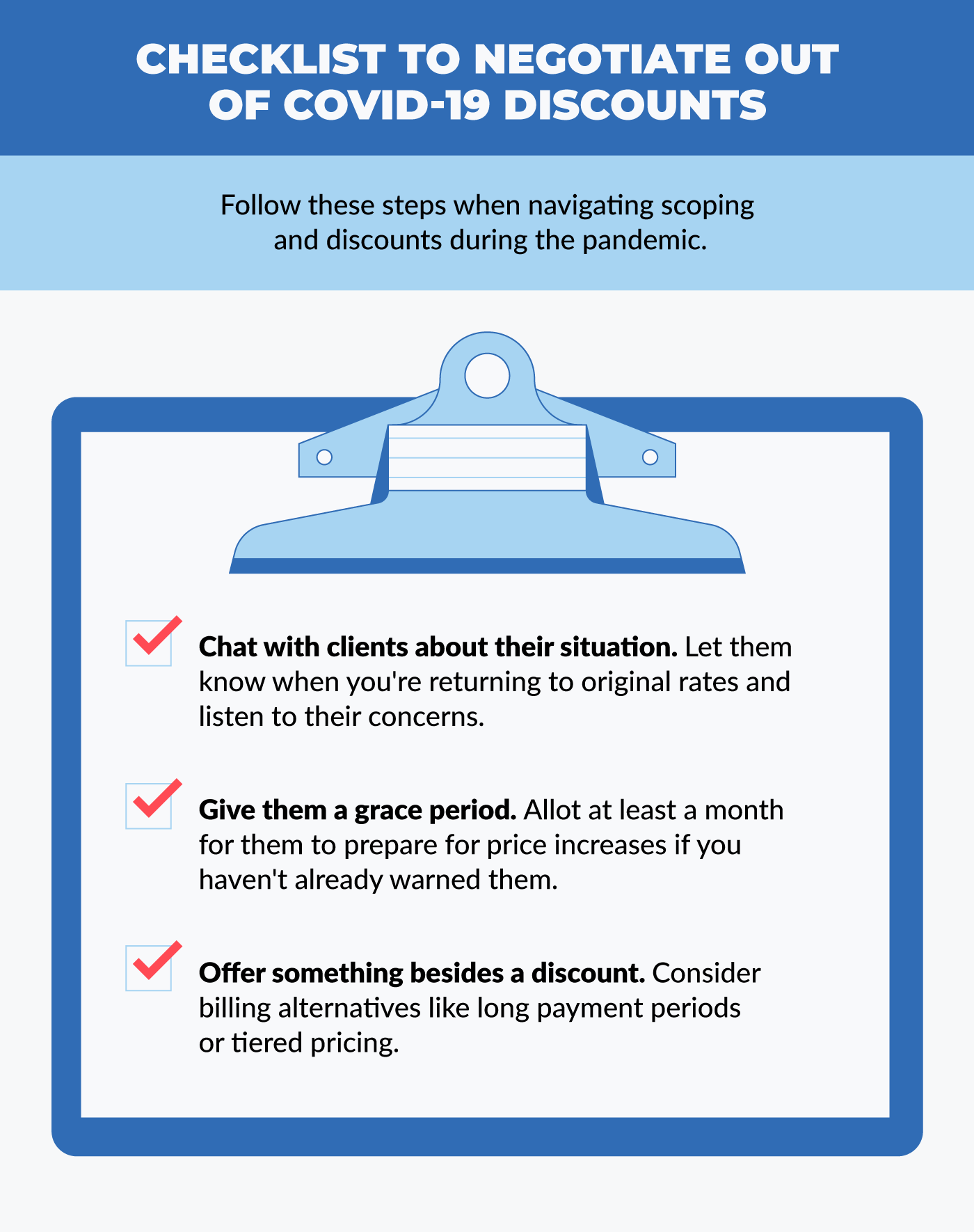
Have a Conversation About Their Situation
Negotiating out of COVID-19 discounts requires having an ongoing conversation with clients about their concerns and your solutions. Tali Raphaely, president of Armour Title Company, says you should prioritize verbal communication to prevent misunderstandings that may come up when communicating via email.
“Remind them that...to help them achieve their goals[,] your company also has to remain profitable and...able to afford to dedicate the needed resources on their company’s account,” he said. “If you aren’t able to make healthy profits[,] it could become more challenging to provide the level of service they’ve come to expect from you.”
Give Them a Grace Period
You ideally should have given clients a timeline of their discount when you first offered a discount. Knowing your deadline upfront will give clients time to prepare and ask questions.
If you did not define an end period for your discount, you should notify clients in advance when planning to transition them back to normal pricing. After you’ve notified all of your clients, post a public notice on social media and your site to cover all of your bases.
WikiLawn Care President Dan Bailey said he sent plans to end their discount a month after they were given. His team also sent periodic reminders to ensure no one was surprised.
Offer Something Besides a Discount
Discounts aren’t sustainable for some businesses and can eat into your working capital. Call Outdoors founder Laurie Wilkins suggested a few alternatives she’s used with her clients. She says that there are always ways to recover the costs of services outside of standard billing. Take a look at some of her suggestions below.
- Tiered pricing structure: Wilkins offered tiered pricing to give customers enough time to adjust back to her normal costs. “In doing this, the client has time to recover losses and ensure sustainability before being hit with full pricing,” she said.
- Extended payment period: Wilkins also offered extended payment cycles to other clients. For example, she moved clients with 30-day payment cycles to 60-day payment cycles. Although she lost out initially, her and her team recovered the full cost of services within the second month.
- Profit share agreement: Finally, Wilkins offered a profit share agreement with a client who needed their software, but couldn’t afford it. This ensures that she retained them without completely losing profit.
Decide on Future Discounts Based on Your Finances, Industry and Clients
There is no one-size-fits-all solution for discounts during the pandemic. Some believe you should do away with discounts as most businesses have recovered. Others say you should continue giving discounts since many are still struggling and the pandemic isn’t over.
This decision is dependent on your business and how your client’s individual industries are faring at this time.
Agnes Fodor is a Project Management Consultant Fodor Agnes EV. She says that there are many things to consider when giving new discounts:
- Is the sector of the client in trouble? Is it going to be better positioned post COVID-19?
- Is your market in a price war? Were your services overpriced to begin with? Should you decrease your value for the sake of following competitors in a discount frenzy?
- What is at stake? Are you about to lose a customer?
Value Transformation LLC Principal Jon M. Quigley says that you should also consider the non-monetary benefits of offering discounts to clients. “...it shows that you as a supplier...are interested in the successes of the client organization – if they are impacted more severely by the COVID-19 pandemic than the supplying organization, providing this discount might help develop the connections between the two organization,” he says. 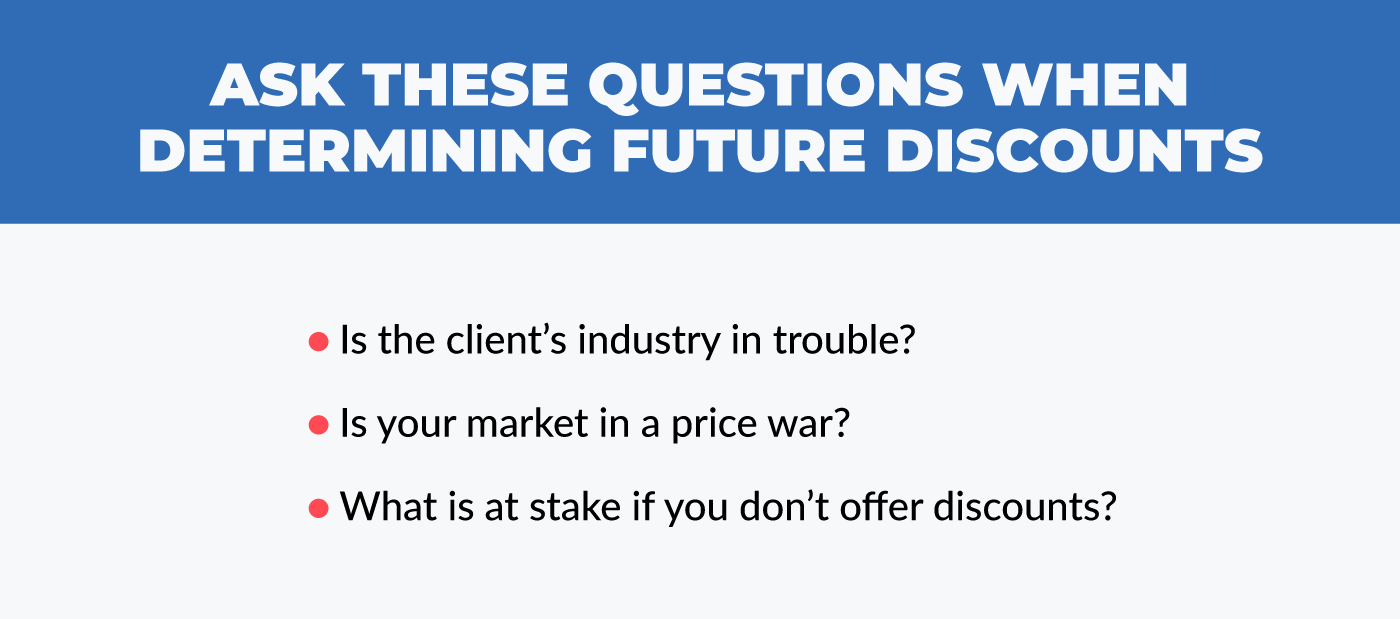
Who Causes Scope Creep?
Stakeholders, clients, and team members can all cause scope creep. This may be a result of clients and stakeholders giving too much feedback or team members getting carried away with extra features. Learn more about how different roles contribute to scope creep.
- Internal stakeholders: Your company’s CEO, your boss, and other departments can end up pushing a project over scope. Top leadership may push you to put in extra time to over deliver on tasks or other departments may take extra time than needed on their deliverables.
- External stakeholders: The client’s boss or other departments can also push you over scope. Your client’s boss may not understand your expectations and deliverables, so they may deliver lots of feedback and request changes. Other departments may add extra requirements that cater to their department’s goals.
- Client: Your client should be the main source of feedback. However, they can also go overboard with changes if they’re too frequent or time consuming. They can also cause the project to go off course if they are slow to respond or don’t give much feedback until the end.
- Team: Finally, your internal team working on the project can push your project off track. They may take longer than anticipated on a specific task or over deliver to the point where it’s costly to your company.
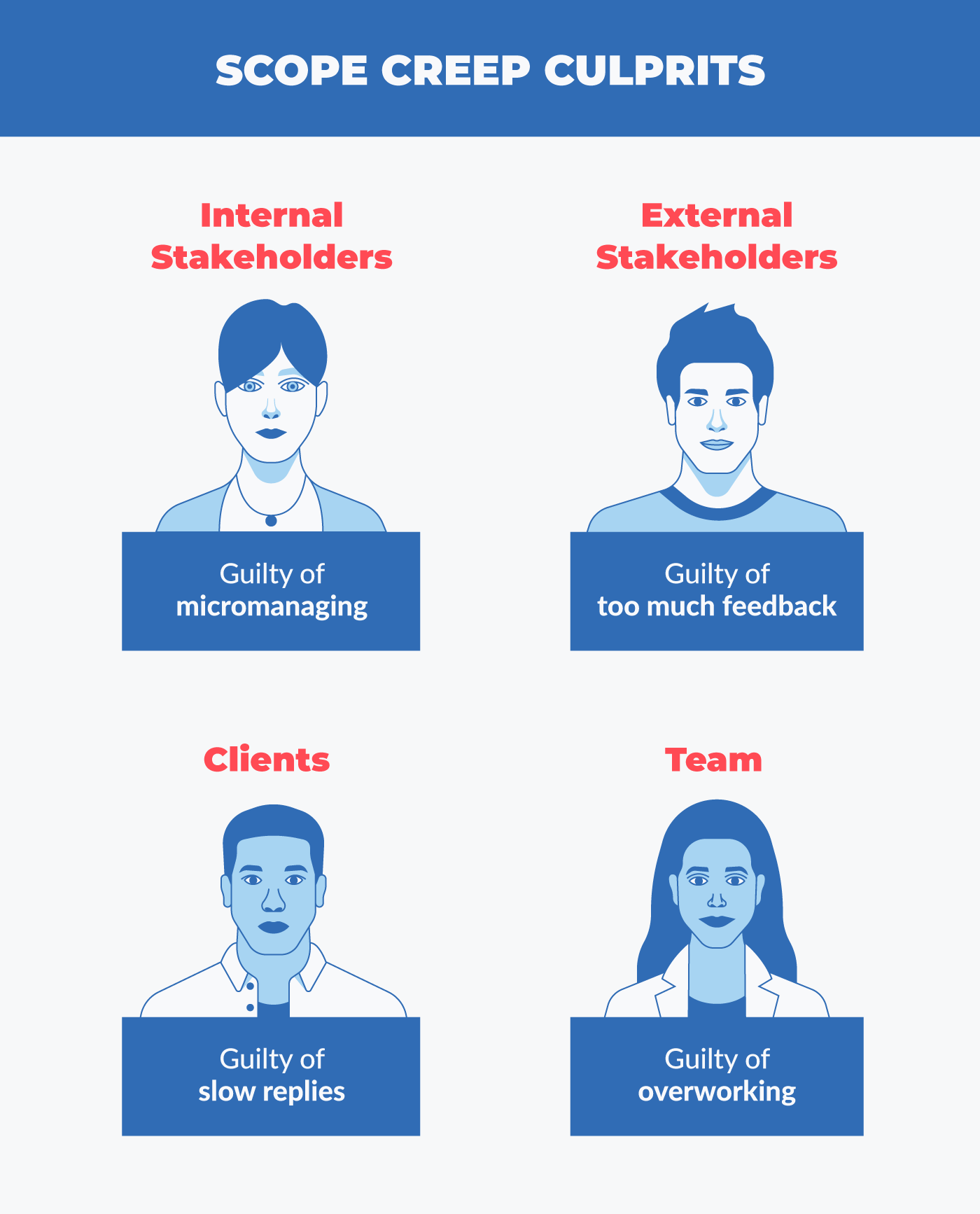
What Causes Scope Creep?
Scope creep happens when changes aren’t efficiently managed and project costs end up higher than originally planned. There are many causes that can happen before and during the project.
Before the Project
Scope creep can begin to grow at the beginning of a project. Failing to set expectations from the start can leave your project open to unexpected and costly changes. We’ll go over a few of these early scope creep causes below.
- Ambiguous scope of work: You should establish deliverables, timelines, budgets, and dedicated team members in the contract. This is obvious for most of us, but small, unclear details can be the start of unexpected changes. Inaccurate estimations can also cause trouble since may end up with the wrong resources for the project. A joint study by KPMG, the Australian Institute of Project Management and the International Project management Association found that only 44 percent of organizations are likely to deliver projects that meet the original goal and business intent.
- Unrealistic timelines and deadlines: Clients may expect quick turnaround times for a project or your team may overestimate how fast they can get the work done. Rushing through a project to meet these deadlines can make communication difficult and ultimately hurt the end product. The same joint study mentioned above found that 30 percent of organizations are likely to deliver projects that are on time.
- Inflexible change process: In project management, a change control process is a set of steps to define proposed changes, evaluate the change, and approve or reject the change. Having a stringent process can help mitigate scope creep, but may limit the success of your project if change is needed. On the other hand, a loose or undefined change process can leave the door open to too many changes. The joint study found that only 30 percent of organizations feel their organizational change management capabilities are very or extremely effective.
- Failure to define milestones and KPIs: Long projects have lots of opportunity to go over scope because of its sheer length. A lack of milestones or KPIs makes it difficult to know how your team is progressing on a project.
- Lack of prioritization: If you and the client aren’t on the same page on what features or goals are their highest priority, then you may end up spending too much time or not enough time on tasks.
During the Project
Scope creep can still occur despite any precautions you may have taken in the beginning. Being too lenient with changes or having poor communication can quickly derail your project. Here are a few ways scope creep can peak its head when you’re working on the project.
- Uncontrolled changes: It’s easy to say “yes” when a client asks for a small tweak. However, approving several small changes can add up fast if you’re not keeping track of: what you’re saying “yes” to, how it’ll impact your project’s scope, and if the change will benefit your project.
- Poor communication: Over and under communicating can cause confusion and stress. This may lead to clients or your team requesting changes that aren’t needed and unplanned time spent on certain tasks.
- Lack of periodic scope check-ins: Routinely checking time and money spent should give you your first red flag when scope is off. However, a lack of check-ins can leave you in the dark until it’s too late.
- Inefficient teamwork: Unclear responsibilities and expectations can set your team back. Ownership confusion and poor communication will hurt your team’s productivity and their ability to work together.
- Gold plating: Gold plating is a project management term used when you’re giving the client more than what they originally asked for in the project. Going the extra mile for clients can be a good thing if you want to establish trust and deliver good service. However, this gets costly if you’re overdelivering to the point where you’re losing time for other projects or spending way too much of your budget on a single client.
- Too many stakeholders: It gets hectic when too many people are involved in the decision-making process. Most people try to push for changes that cater to their goals. It can cost a lot of time and money to please multiple stakeholders. A paper presented during the Construction Research Congress in 2018 found that two main indicators of scope creep and change orders in construction projects directly related to the number of joint venture partners in a project and executive oversight entities above the project management level.
- Stakeholders aren’t involved enough: Silent clients can also pose a problem. If you don’t push clients and other stakeholders for more feedback, team’s naturally end up doing what they think is best and potentially getting things wrong. Disengaged clients can also delay projects if approval is needed before moving forward. A lack of engagement could also mean that client expectations and required involvement isn’t clear to them. A study published in the International Journal of Medical Informatics found that stakeholder creep contributed to a 3-month delay in the project and the team going 68% over expected work hours.
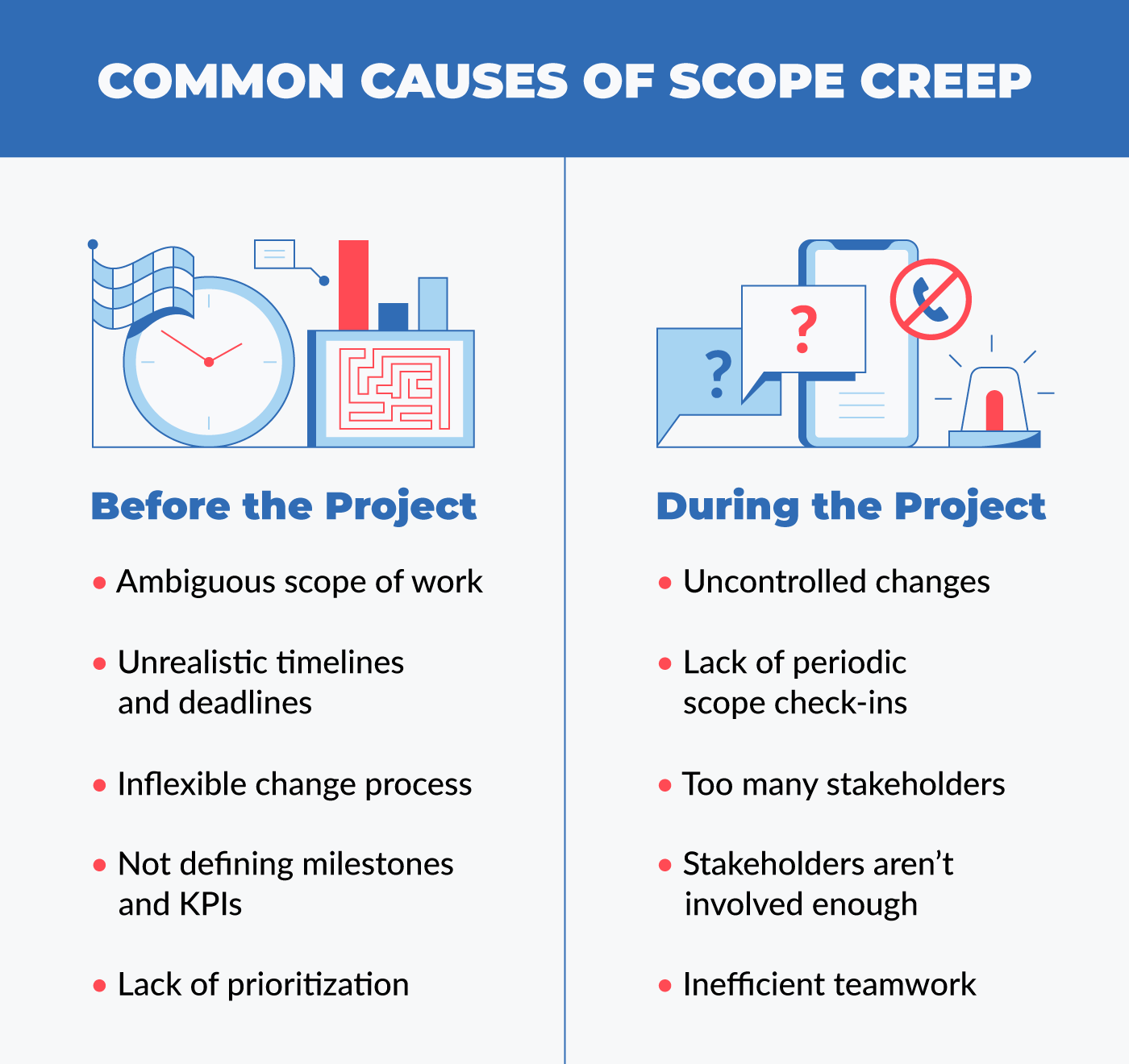
How Can I Identify Scope Creep?
You can identify scope creep by keeping a close eye on your project’s scope, your team’s performance, and your client’s feedback. Here are a few ways to identify scope creep before it’s too late.
- Your team is working late. Overworked team members could be a sign that a project’s deadline is too tight or the project isn’t properly scoped. Keep an eye on team members who are clocking long hours, especially those who don’t normally stay late.
- Project costs are high early in the project. A high bill early on can be a sign that you’re spending too much time or money on this project. Wellingtone’s report found that poor resource management was among the top three project management challenges.
- The client has a lot of feedback and changes. Feedback is inevitable, but a constant stream of feedback might mean that you and your client aren’t on the same page.
- Many people are giving feedback. The only thing worse than getting lots of feedback from the client is getting lots of feedback from different people on your client’s team.
- Your team is constantly tweaking the project. You may have an overachiever on the team or someone who never seems to be satisfied with their work. Both of these people can unintentionally hold your project back if they keep looking for things to fix.
- Your team isn’t working together. Lastly, a lack of teamwork could be a sign that something internally isn’t working for your team. It could be communication, ownership, expectations, or something else. A project could be in trouble if your team members are mostly working alone and aren’t communicating progress or changes to each other.
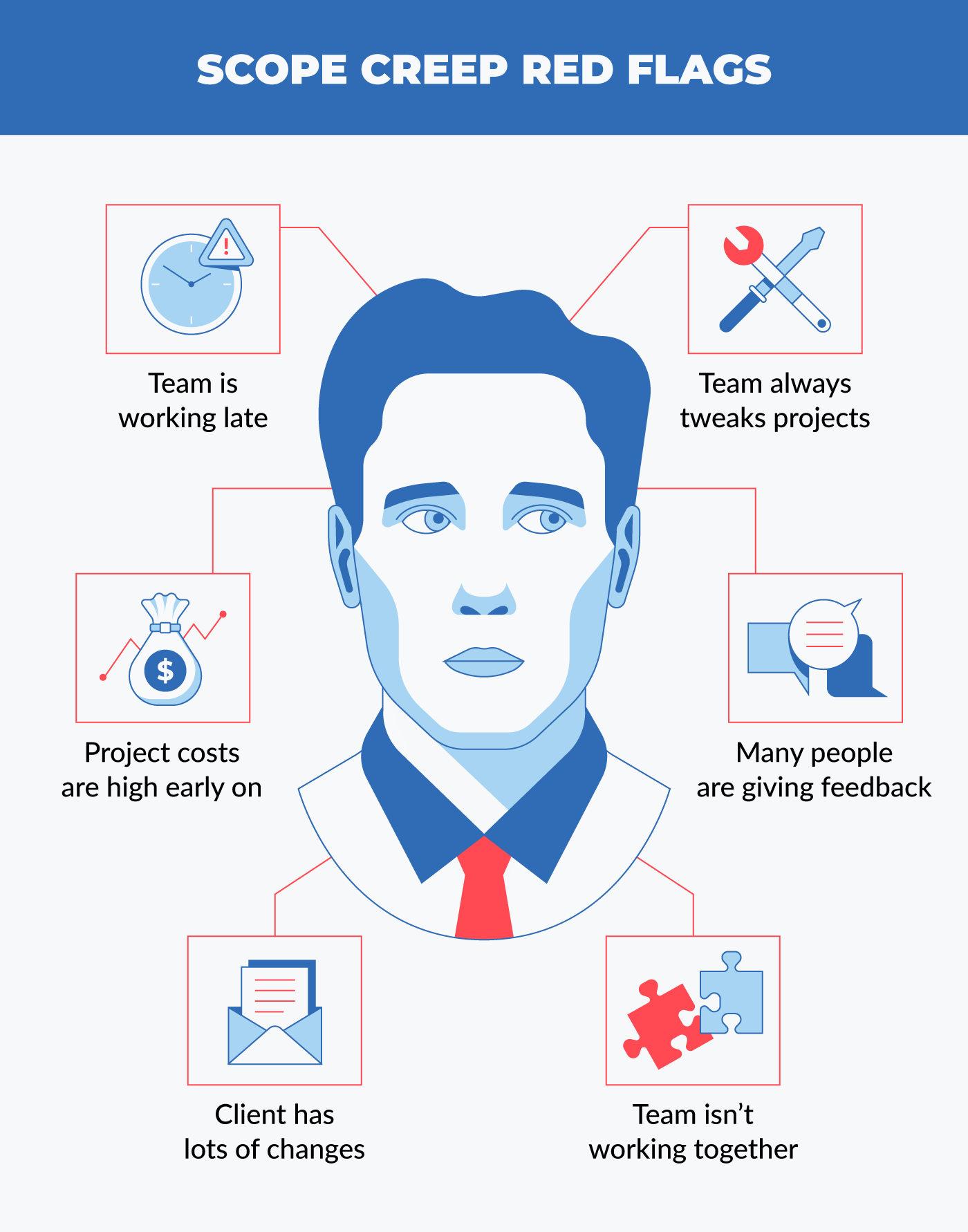
How Can I Manage Scope Creep?
You can manage scope creep by setting clear expectations from the beginning, periodically checking in on scope, and constantly communicating with clients and your team. Learning how to manage scope creep is one way to recession-proof your business so you can keep unnecessary costs at a minimum. We have a few actionable tips to help you manage scope creep.
- Define scope in the beginning: Eliminate ambiguity from the beginning by laying out all costs, time allotments, and deadlines for each part of the project. Wellingtone’s report found that 61 percent of project managers mostly or always create a scoping document as part of planning.
- Include deliverables that are out of scope for the project: Letting clients know what is out of their budget helps manage their expectations. Defined deliverables give them concrete examples of what isn't realistic and can eliminate requests that are clearly over budget. Elizabeth and Richard Larson explained in a Project Management Institute (PMI) paper that scope statements should include features that are in and out of scope.
- Have a defined process to handle changes: A formal process ensures you’re keeping the project’s full scope and goals in mind before making any changes. Ideally, you want the person proposing an idea to fully define what it is. Then, you’d evaluate the pros and cons. Finally, you’ll decide if it’s beneficial to implement. This may sound rigid for some, but a formal process makes requests more manageable and ensures changes contribute to your goal. Digital strategy consultant Connor Whitman says you shouldn’t be afraid to tell a client “no” when they want to make a change. “...learning how to be diplomatic and set boundaries is a must for anyone who wants to be successful in business. You'd be surprised how receptive and understanding clients can be to a hardline stance on scope,” he said.
- Keep updated documentation of scope changes: A paper trail can hold everyone accountable with any changes in goals and scope. It also records any changes in cost, time, and labor to ensure nothing slips through the cracks.
- Routinely compare costs, time spent, and work completed to your original estimates and plans: Periodic scope check-ins are necessary to ensure your project is on track. You can catch scope creep early on before it gets out of hand. Wellingtone’s report found that 60 percent of project managers always or mostly engage in risk assessment.
- Be proactive about changes needed. Anticipating problems before they come up gives you more time to find solutions and pivot before issues get worse. Agnes Fodor also explains that well-functioning teams spot scope creep early. “...[managers] need to be able to cascade the responsibility of identifying risks through the organisation…” she said. “Use the organisational culture as a vehicle to avoid unnecessary costs related to scope-creep.”
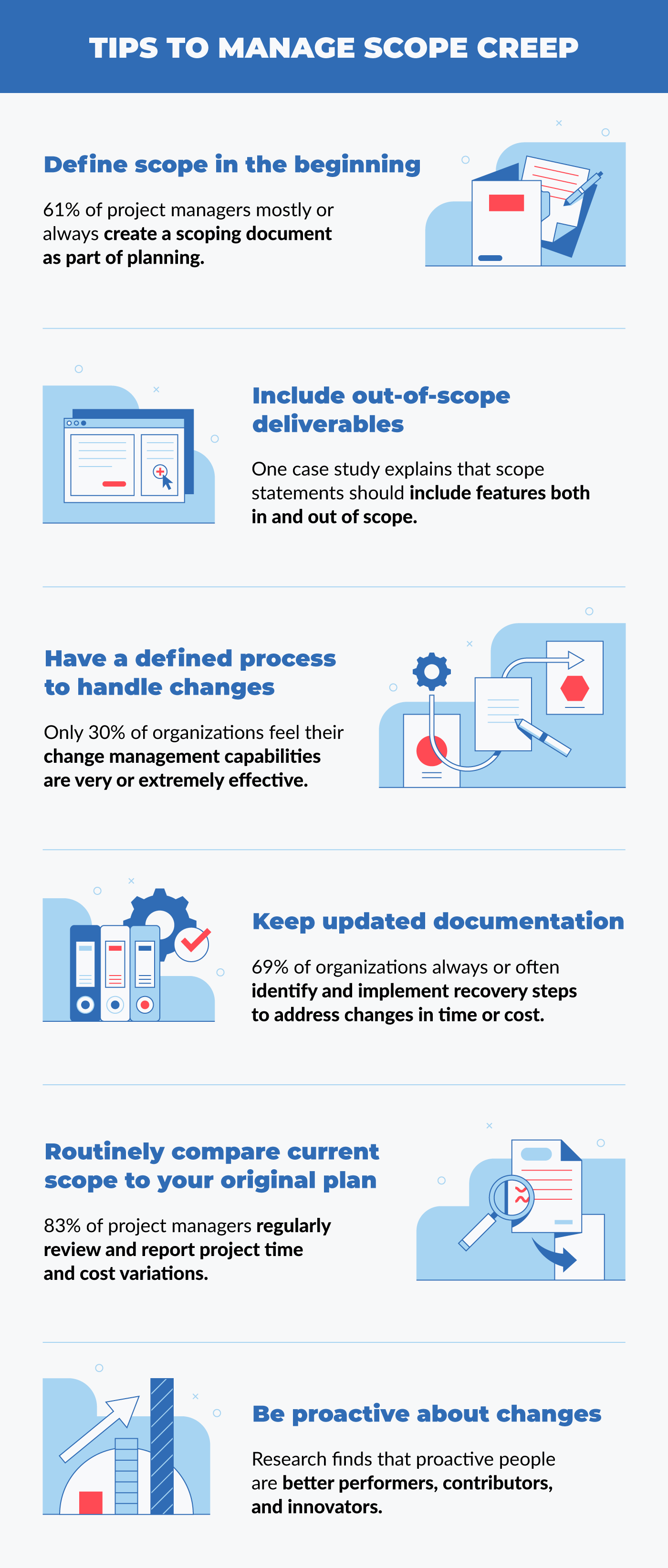 Scope creep can derail a project and hurt client relationships if it’s not caught early and effectively managed. Take a proactive approach with your project’s scope and establish expectations early on to ensure everyone’s on the same page. If you’d like to learn more about scope creep, check out our infographic below.
Scope creep can derail a project and hurt client relationships if it’s not caught early and effectively managed. Take a proactive approach with your project’s scope and establish expectations early on to ensure everyone’s on the same page. If you’d like to learn more about scope creep, check out our infographic below.  Sources: Wellingtone | IPMA | Harvard Business Review | Proactivity at Work
Sources: Wellingtone | IPMA | Harvard Business Review | Proactivity at Work




Leave a Reply